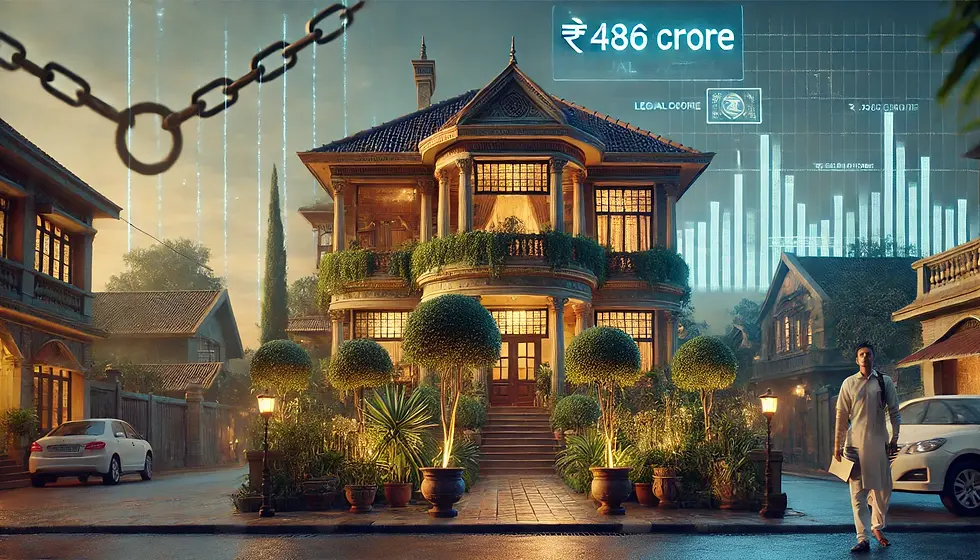NaMo Bharat RRTS: A Transformational Leap in NCR Transit Connectivity
- Team Mariners Realty
- Jan 12
- 4 min read

The National Capital Region (NCR) is on the cusp of a transformative transit revolution with the launch of the NaMo Bharat Regional Rapid Transit System (RRTS). This ambitious infrastructure project aims to link Greater Noida and Gurgaon, significantly reducing travel time and enhancing regional connectivity.
Designed with state-of-the-art technology and a focus on inclusivity, the RRTS promises to redefine the commuting experience for millions of residents.
A Game-Changer for NCR Connectivity
The NaMo Bharat RRTS will connect Gurugram’s Hero Honda Chowk to Greater Noida, providing seamless access to key areas such as Cyber City, Rajiv Chowk, Bhondsi, Kherki Daula, and Pachgaon. With an innovative design that integrates existing metro systems and road networks, the project is expected to alleviate traffic congestion, streamline transit routes, and cut travel times drastically.
This project represents a pivotal shift in how urban and semi-urban regions are interconnected. The integration with metro systems ensures commuters can easily transition between different modes of transportation, creating a unified and efficient network.
Inclusive Growth and Social Equity
A standout feature of the NaMo Bharat RRTS is its commitment to inclusivity. The project aims to bridge the gap between rural and urban areas, fostering economic growth and promoting social equity. By connecting villages like Kherki Daula and Pachgaon with major urban hubs, the RRTS ensures that rural communities also benefit from enhanced connectivity and infrastructure.
Additionally, plans for a train gate near the upcoming ISBT at Kherki Daula underscore the project’s dedication to accessibility, making it easier for travellers to move across the region.
Construction in Unified Phases for Swift Completion
The NaMo Bharat train will be constructed in a single unified phase, running from Sarai Kale Khan to Dharuhera. This approach aims to streamline construction, ensuring a faster rollout of the service.
In a pivotal meeting on October 22, 2024, Housing and Urban Minister Manohar Lal and Haryana Chief Minister Nayab Singh Saini finalized plans for the project. The collaborative efforts between state and central agencies highlight the significance of this project in advancing regional development.
Boosting Economic and Residential Development
The NaMo Bharat RRTS is set to be a catalyst for economic and residential growth across the NCR. By connecting hubs like Old Gurugram and Cyber City, the project encourages investments, supports new business opportunities, and enhances the region's appeal as a residential destination.
Moreover, improved access to major transit points is expected to reduce commuting stress, thereby improving the overall quality of life for residents.
Implications for Real Estate in NCR
The RRTS project is poised to transform the real estate landscape across the NCR. Enhanced connectivity between key urban centers and the integration of rural and suburban areas will significantly boost the real estate sector in several ways:
Increased Demand for Housing:Areas near RRTS stations, such as Kherki Daula, Rajiv Chowk, and Hero Honda Chowk, are likely to witness a surge in demand for residential properties. With reduced travel times, these locations will become more attractive to working professionals seeking affordable housing options outside the city core.
Appreciation of Property Values:Improved transit infrastructure often leads to an increase in property values. Homes, commercial spaces, and land parcels in close proximity to RRTS corridors are expected to experience substantial appreciation, offering lucrative opportunities for investors.
Emergence of New Growth Corridors:The seamless integration of rural and urban areas will open up new growth corridors, particularly around areas like Pachgaon and Bhondsi. These regions, previously underdeveloped, will benefit from better infrastructure and accessibility, driving urbanization and real estate development.
Boost to Commercial Real Estate:The RRTS will make NCR a more connected region for businesses. Improved accessibility to key commercial hubs like Cyber City and Hero Honda Chowk will enhance the appeal of office spaces in these areas, drawing companies looking to expand their operations.
Shift in Buyer Preferences:With faster and more reliable commuting options, buyers are likely to explore suburban properties that offer better amenities at competitive prices. This shift will drive developers to focus on integrated townships and housing projects near RRTS stations.
Development of Affordable Housing:The focus on inclusivity and rural-urban integration will encourage the development of affordable housing projects in areas like Kherki Daula and Pachgaon, meeting the needs of middle-income buyers and fostering balanced regional development.
Future of Transit in NCR
The NaMo Bharat RRTS marks a monumental leap forward for NCR’s transit infrastructure. Seamless integration with metro systems, along with new infrastructure like the ISBT at Kherki Daula, is poised to set a benchmark in urban transportation. By offering faster, more reliable, and efficient transit options, the RRTS will redefine how millions of people commute, work, and live.
A Vision of Progress and Integration
As India continues to modernise its infrastructure, the NaMo Bharat RRTS stands out as an exemplary project that prioritises efficiency, inclusivity, and economic growth. By bridging critical transit hubs and fostering regional development, it promises to empower urban and rural communities alike.
This transformative initiative not only addresses the immediate needs of NCR’s rapidly growing population but also paves the way for future advancements in transportation and real estate development. With its visionary approach, the NaMo Bharat RRTS sets a precedent for the rest of the country, proving that inclusive and sustainable development is the key to progress.



Comments